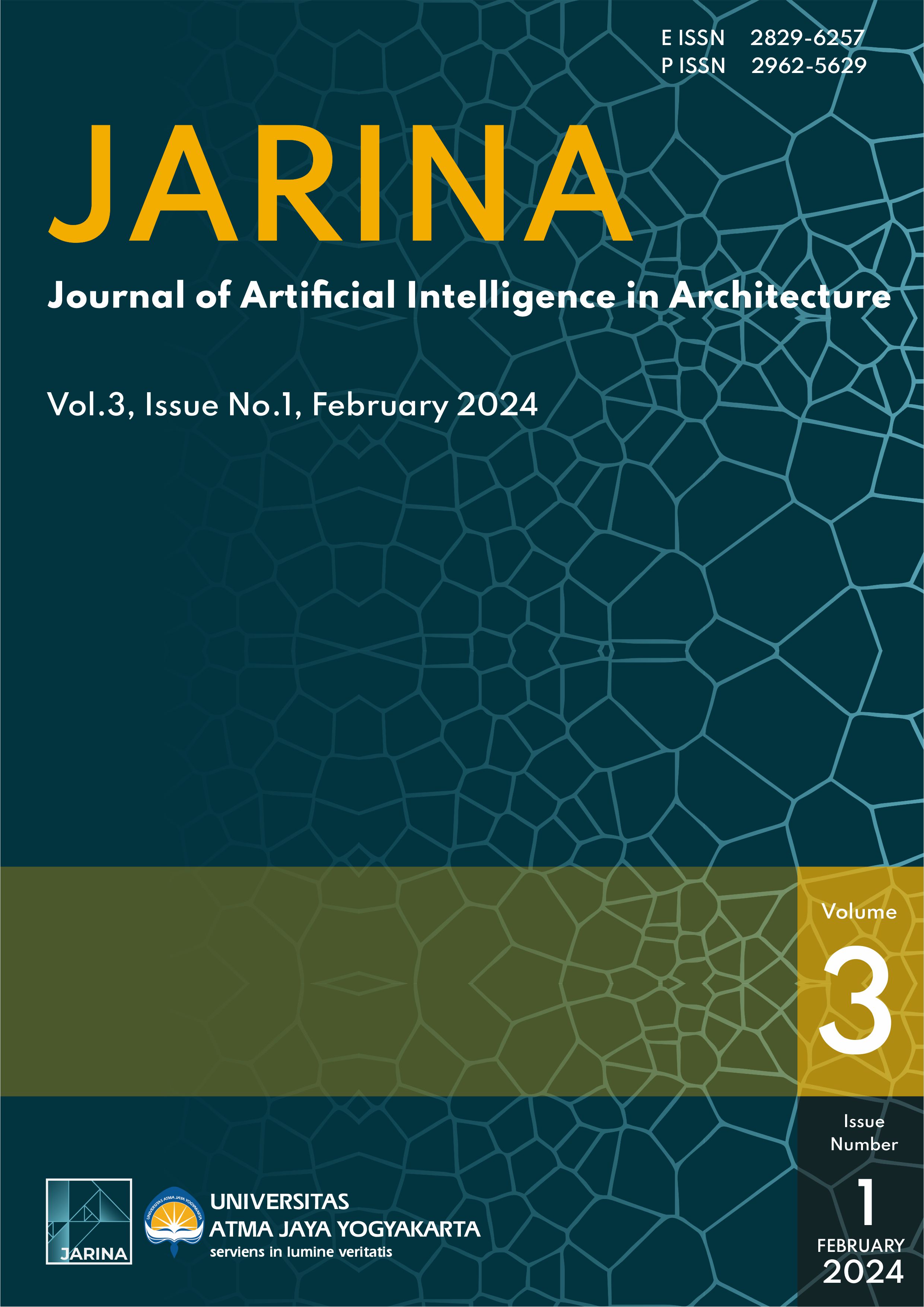The Organic Challenge: The Organic Challenge: Cultivating Conscious Design for Biodigital Tectonics within AI’s Prompt-to-Pixel Process
DOI:
https://doi.org/10.24002/jarina.v3i1.8157Keywords:
Biodigital Architecture, Artificial Intelligence (AI), Midjourney , Digital Tectonics, Digital Design ProcessAbstract
The fusion of digital advancements and biological systems is transforming modern-day architecture, and this bio-digital approach, when paired with AI image generation models, promises novel design possibilities. The major drawback of this merger is the dismal performance of AI text-to-image models in translating organic tectonic details into architecture. This study examines the complexity of processes, materials, and techniques necessary in a bio-digital architectural approach. Through a series of digital trials, it identifies the need for sophisticated computational models that can capture the complex intricacies and subtle nuances present in living organisms. Before the testing, a set of parameters considered the limitation of how much tectonic information an image could portray. The Nautilus Shell, ferns, mushrooms, seahorses, and grasshoppers were taken as inspiration models because of varying biological configurations. Next, two AI image-generating tools, Midjourney and Stable Diffusion, were used with three different prompt types, each with varying degrees of complexity drawn from five organic systems. A critical analysis of AI-generated images led to the conclusion that, despite AI's exceptional abilities in creating visual content, the complex comprehension of biological systems and their conversion into architectural designs faced significant challenges.
References
H. Al-Alwan and Y. B. Mahmood, “The Connotation of Tectonics in Architectural Theory,” IOP Conference Series: Materials Science and Engineering, vol. 745, p. 012161, Mar. 2020, doi: https://doi.org/10.1088/1757-899x/745/1/012161.
R. Hermanson and J. Bermudez, “Tectonics After Virtuality: Returning to the Body,” Proceedings of ACSA International Conference: “Constructions of Tectonics for the Postindustrial World, Jan. 1996, Accessed: Oct. 23, 2023. [Online]. Available: https://www.academia.edu/2902364/Tectonics_After_Virtuality_Re_turning_to_the_Body
D. Pearson, New Organic Architecture: The Breaking Wave. Univ of California Press, 2001. Accessed: Oct. 23, 2023. [Online]. Available: https://books.google.com.pk/books?hl=en&lr=&id=5fncJliXFdgC&oi=fnd&pg=PA58&dq=organic+architecture&ots=ngKjJgFXhw&sig=_DOaCkL9icPT0mOfvssLsYWF-tc&redir_esc=y#v=onepage&q=organic%20architecture&f=false
H. Al-Alwan and Y. B. Mahmood, “The Connotation of Tectonics in Architectural Theory,” IOP Conference Series: Materials Science and Engineering, vol. 745, p. 012161, Mar. 2020, doi: https://doi.org/10.1088/1757-899x/745/1/012161.
A. T. Estévez and D. Navarro, “Biomanufacturing the Future: Biodigital Architecture & Genetics,” Procedia Manufacturing, vol. 12, pp. 7–16, 2017, doi: https://doi.org/10.1016/j.promfg.2017.08.002.
P. Gruber, T. McGinley, and M. Muehlbauer, Towards an agile biodigital architecture - Supporting a dynamic evolutionary and developmental view of architecture. 2017.
D. Ozkan, M. Dade-Robertson, R. Morrow, and M. Zhang, “Designing a Living Material Through Bio-Digital-Fabrication: Guiding the growth of fungi through a robotic system,” vol. 1, V. Stojaković and B. Tepavčević, Eds., Brussels: Education and Research in Computer Aided Architectural Design in Europe (eCAADe), 2021, pp. 77–84. Accessed: Oct. 23, 2023. [Online]. Available: http://papers.cumincad.org/cgi-bin/works/paper/ecaade2021_022
D. Dollens, “Architecture as Nature: a Biodigital Hypothesis,” Leonardo, vol. 42, no. 5, pp. 412–420, Oct. 2009, doi: https://doi.org/10.1162/leon.2009.42.5.412.
C. Naglik, F. Rikhtegar, and C. Klug, “Buoyancy of some Palaeozoic ammonoids and their hydrostatic properties based on empirical 3D-models,” Lethaia, vol. 49, no. 1, pp. 3–12, Jan. 2016, doi: 10.1111/let.12125.
A. Lukeneder, “Ammonoid Habitats and Life History,” in Ammonoid Paleobiology: From anatomy to ecology, C. Klug, D. Korn, K. De Baets, I. Kruta, and R. H. Mapes, Eds., in Topics in Geobiology. , Dordrecht: Springer Netherlands, 2015, pp. 689–791. doi: https://doi.org/10.1007/978-94-017-9630-9_18
J. Pšenička, R. Rößler, J. Frojdová, S. Opluštil, and M. Merbitz, “A new anatomically preserved Alloiopteris fern from Moscovian (Bolsovian) volcaniclastics of Flöha (Flöha Basin, SE Germany),” PalZ, vol. 93, no. 3, pp. 395–407, Sep. 2019, doi: https://doi.org/10.1007/s12542-019-00482-x
D. S. Hibbett, D. Grimaldi, and M. J. Donoghue, “Fossil mushrooms from Miocene and Cretaceous ambers and the evolution of Homobasidiomycetes,” American Journal of Botany, vol. 84, no. 7, pp. 981–991, 1997, doi: https://onlinelibrary.wiley.com/doi/abs/10.2307/2446289
J. Žalohar, T. Hitij, and M. Križnar, “Two new species of seahorses (Syngnathidae, Hippocampus) from the Middle Miocene (Sarmatian) Coprolitic Horizon in Tunjice Hills, Slovenia: The oldest fossil record of seahorses,” Annales de Paléontologie, vol. 95, no. 2, pp. 71–96, Apr. 2009, doi: https://www.sciencedirect.com/science/article/pii/S0753396909000172
G. S. Boyan, J. L. D. Williams, and H. Reichert, “Morphogenetic reorganisation of the brain during embryogenesis in the grasshopper,” Journal of Comparative Neurology, vol. 361, no. 3, pp. 429–440, 1995, doi:https://onlinelibrary.wiley.com/doi/abs/10.1002/cne.903610307
N. ShaoXiang, J. JianJun, W. JieChen, G. AiQi, W. WeiJuan, and F. Voss, “Environmental conditions affecting grasshopper epidemic in the region around Qinghai Lake.,” Acta Prataculturae Sinica, vol. 9, no. 1, pp. 43–47, 2000.
P. J. Cobb, “Large Language Models and Generative AI, Oh My!: Archaeology in the Time of ChatGPT, Midjourney, and Beyond,” Advances in Archaeological Practice, vol. 11, no. 3, pp. 363–369, Aug. 2023, doi: https://www.cambridge.org/core/journals/advances-in-archaeological-practice/article/large-language-models-and-generative-ai-oh-my/314BA1339E6908606B90202C0DEF266E
T. K. F. Chiu, “The impact of Generative AI (GenAI) on practices, policies and research direction in education: a case of ChatGPT and Midjourney,” Interactive Learning Environments, vol. 0, no. 0, pp. 1–17, 2023, doi: https://doi.org/10.1080/10494820.2023.2253861
Downloads
Published
How to Cite
Issue
Section
License
Copyright (c) 2024 Farina Shahid

This work is licensed under a Creative Commons Attribution 4.0 International License.
Authors who publish with this journal agree to the following terms:
1.Authors retain copyright and grant the journal right of first publication with the work simultaneously licensed under a Creative Commons that allows others to share the work with an acknowledgement of the work's authorship and initial publication in this journal.
2.Authors are able to enter into separate, additional contractual arrangements for the non-exclusive distribution of the journal's published version of the work (e.g., post it to an institutional repository or publish it in a book), with an acknowledgement of its initial publication in this journal.
3.Authors are permitted and encouraged to post their work online (e.g., in institutional repositories or on their website) prior to and during the submission process, as it can lead to productive exchanges, as well as earlier and greater citation of published work (See The Effect of Open Access).

















